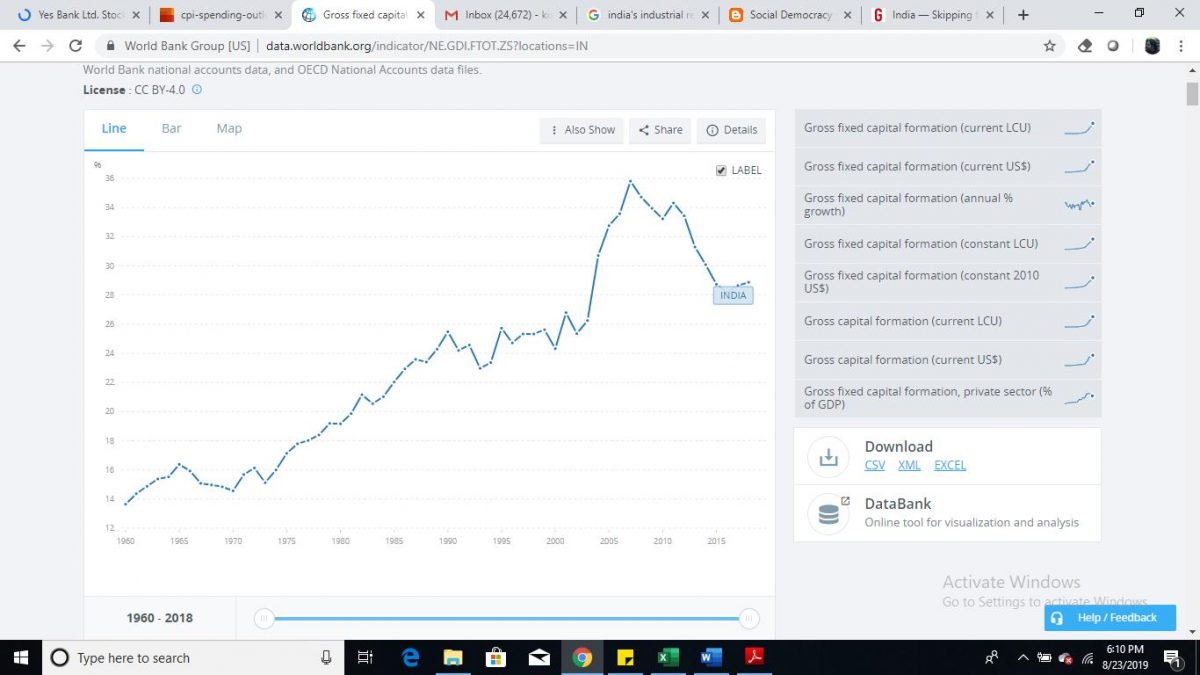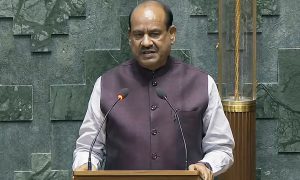A few days back I received a forward on WhatsApp, which said “the economy is not failing but business models are changing”, it was a curious forward in the sense that it spoke about Car sales falling but Uber rides increasing and restaurants seeing lower footfalls but food deliveries increasing; the kind of statement that makes you want to check the veracity of this claim. Incidentally, during the same time I was reading a book Platform Revolution by Geoffrey Parker, Marshall and Sangeet Paul.
It talks about the current tech-aggregation revolution, how it is affecting the competition in the market and how old economy companies are coping with it. So, at the outset I would like to submit that I would be borrowing their ideas to convey my understanding of how the Indian economic growth is shaping up.
The Economy and its story
If Industrial revolution is considered as the big bang event in the world of “formal” economics, then the “current” Indian economy can be assumed to be in the epoch where dinosaurs are almost coming to their end, either by going extinct or evolving into a newer species that can adapt to the changing conditions (remove the timescale perspective from this analogy). The changing conditions could have been external or internal. In the case of companies, it could be how the competition is shaping up within the industry as well as the consumer preference and the government initiatives for change (think BS-VI and EVs in Autos). But to appreciate this it also becomes imperative that the economic maturity of countries is understood. Every economy in the world goes through multiple stages as it matures into an automated stable structure. The American economy underwent this revolution from a pure agrarian economy to the current Network driven one. (Source: Deloitte) I pick the American economy because it remains a beacon of unadulterated capitalism, which is tough to emulate by any country in the world.

India per se did not have a full-blown industrial revolution like in the west that served the local population. India was a global leader in cotton in the 1700s and 1800s but during colonization most of the industries were catering to the demand outside, essentially becoming a manufacturing hub much like China in the 2000s. Post-independence was a different story as socialism took over and it took almost till the 90s for the Gross fixed capital formation as a % of GDP to 25%+ and the GDP growth to accelerate to ~8%. But to be fair most of this GDP was driven by services as manufacturing and allied services added only ~15% of India’s GDP from the 1960s and hasn’t changed. To give you a perspective, China’s is more than twice as that of India. A case that asset utilization has been inefficient in India can be built.
India’s Gross Capital Formation as a % of GDP

In effect, India shifted from being an agrarian economy (~41% of GDP in 60s to ~15% of the GDP in 2018, source: World Bank) to a services economy where the contribution from services has increased from ~30% in 1960s to ~50% in 2018 – the ~45-50% contribution is at a time when India was the second fastest growing economy in world after China in the 2000s and the fastest growing post 2015s. (more statistics can be found here)
Double whammy and the current state
As these changes were happening in the India, the economies across the world changed from being supply driven to demand driven. This is a very important factor that needs consideration as this impacts the old economy companies (manufacturing, Industrials etc.) that undertake long gestation projects to put up capacity to cater to the change in demand. Along with the market being driven by customer preferences, the advent of technology has spawned new-age business models: “platforms”, “eco-systems”, “networks” etc (Reference: Pipelines, Platforms, and the New Rules of Strategy). These “ecosystems” not only compete with one another they compete with the old school companies as well and across geographies. For example:
Google is not just a search engine; it is a consumer durable company – Google Nest competes/will compete with Phillips or Havells
Google pixel competes with Samsung and other smart phone companies
Google Waymo competes with automobile companies
Airtel is not just a telecom company; it competes with cable service providers
Uber is not just a cab hauling company – it competes with restaurants and car manufacturers
Tesla competes with Power utilities, car manufacturers and even space companies
The old economy companies will have to contend with competition not only from within their industries but also from outside and unrelated entities. The main enabler for this is technology and the new economy companies, despite failures that they encounter, achieve this with much lower gestation periods and relatively lower investments across time periods. These have very telling effects on an economy during the transition phase.
Case in point – Food Economics
Let’s take food delivery as a case in point, the Food and restaurant industry in India ~USD45Bn out of which a third is online delivery where Zomato and Swiggy compete. For every delivery order that is placed through an online platform, no vegetables need to be bought, the amount of provisions spent per month would come down, amount of cooking gas spent would come down along with others. Though you might argue that the similar consumables would be used by restaurants; the number of players in the Food value chain have gone up and the net value added for each one of them would go down for some time before some semblance of stability comes in. The main reason being, we are no longer in a linear “pipeline” sort of a value chain but a “platform” where each restaurant will have to fight for visibility and pay for the platform provider (like Zomato or Swiggy) (reference: McKinsey; JM Financial) and in the short term, all platforms burn cash because of subsidies from “PE funds” (reference: Hindu Business line). On top of this every investment made in retail grocery stores does not make profits. There are 12mn small grocery retailers that control 90% of the grocery market which is valued at $810bn by 2020 (source: Indian Retailer) these retailers have received ~USD1Bn FDI over the last 17 years (source: ibef) including domestic investments that would be thrice of the FDI investments. These investments would have added considerably less value towards the GDP growth. So, the traditional restaurant industry competed with the offline delivery model, which later competed with the platform or online delivery model and all of them are struggling to add value to the economy.
Similar parallels can be drawn for the competition between an Automobile company and a cab-hauling company and an ecosystem company like Google, etc.
Why is it unique in India?
Thus, the Indian economy is going through a double whammy of “platform” based business models and structural change in the economy where the consumers are driving the demand. This impact might not be felt to a great extent in countries like the United States because there was a sequence to the changes that happened. Telecom penetration happened over the 60s through the 80s which enabled adoption of mobile phones easy. The mobile adoption made the adoption of smart phones and the ecosystem easy and the adoption of the ecosystem made the adoption of platform-based models easy. The entire change was linear until the tech boom which made the change exponential and this exponential growth spread to developing economies like India. In India a lot of changes are happening in parallel:
We have mobile phone penetration at ~65-70% to increase to 90% in the next couple of years
Complete electrification both urban and rural
India’s move into an EV ecosystem
Adoption of LEDs which brought down power consumption
If we take the LED adoption, his has led to savings of ~225Kwh/year which translates to ~6750Kwh/year (source: CPRI), this amount of power need not be generated or can be used elsewhere. At the same time Solar panels and LEDs lightbulbs might not be good for traditional utilities in another part of the world, (ref: MotherJones) and we are not too far off. In fact, there will not be too many new thermal capacities which will be put up in the next couple of years, which has dampened the earnings of power equipment manufacturers like BHEL.
Conclusion – Slowdown might not be as acute as perceived! We might be missing a few parameters
The GDP of any country is dependent on the business models that companies have and the structure of demand that drives the economy. To say that the change in business models from old age manufacturing to new-age aggregation and digitization would not impact the economic growth is very naïve. India as a country with ~135crore people with almost a bottomless demand for products and services might not really encounter a slowdown in consumption but a slowdown in the way the old economy products and services are consumed, which is what is perhaps being captured by the current GDP calculation methodology. This shift in consumption trend/pattern might need to be incorporated as a separate factor in the GDP which might give us a correct picture (the GDP growth might turn up 50bps higher) (further reading: iariw). Again, this is argument is not to completely negate the prevalent sentiment regarding the economy but to look at economic growth from a different perspective.

Author: KishoreChidambaram works in the treasury dept of a major Insurance company and have got 12+ years experience in Equity Research and Asset management, can be reached on Twitter @kishoreciyer1
Reference
- https://www.amazon.in/Platform-Revolution-Networked-Transforming-Economy/dp/0393249131
- https://www2.deloitte.com/content/dam/Deloitte/us/Documents/risk/us-ers-global-report-on-technology-and-the-economy.pdf
- https://data.worldbank.org/indicator/NE.GDI.FTOT.ZS?locations=IN
- http://statisticstimes.com/economy/sectorwise-gdp-contribution-of-india.php
- https://hbr.org/2016/04/pipelines-platforms-and-the-new-rules-of-strategy
- https://www.mckinsey.com/industries/high-tech/our-insights/the-changing-market-for-food-delivery
- http://jmflresearch.com/JMnew/JMCRM/analystreports/pdf/JMFLINFOE_CompanyUpdate_17May2017.pdf
- https://www.thehindubusinessline.com/companies/zomato-says-incurred-294-million-loss-nos-revenue-tripled-to-206-million-noin-fy19ep/article26749529.ece
- https://www.indianretailer.com/article/sector-watch/food-and-grocery/How-Indian-grocery-business-is-becoming-big.a6147/
- https://www.ibef.org/download/Retail-Report-2018.pdf
- https://cprindia.org/news/6527
- https://www.motherjones.com/environment/2014/07/destroy-electricity-demand-utilities/
- http://www.iariw.org/copenhagen/coyle.pdf




























 WhatsApp us
WhatsApp us